#Hash or Encrypt
Explore tagged Tumblr posts
Text

#Control IT
1 note
·
View note
Text
Which of the following is a technique used to protect data integrity?
Which of the following is a technique used to protect data integrity? A. Encryption B. Hashing C. Steganography D. Both A and B
The correct answer is:
D. Both A and B
Both encryption and hashing are techniques used to protect data integrity.
Encryption is primarily used to protect data confidentiality by encoding information so that only authorized parties can access it. However, some encryption methods also offer integrity protection by including checksums or cryptographic hashes to detect if the data has been altered.
Hashing is a technique that involves creating a fixed-size hash value from a set of data. It is used to verify the integrity of the data by comparing the hash value of the data before and after transmission or storage to check for any alterations.
Therefore, both encryption and hashing can be used to protect data integrity. Steganography, while useful for hiding information within other files or media, does not inherently protect data integrity.
0 notes
Text
Is Torrenting Legal and Safe? - Technology Org
New Post has been published on https://thedigitalinsider.com/is-torrenting-legal-and-safe-technology-org/
Is Torrenting Legal and Safe? - Technology Org
These days, files are ballooning in size, straining our storage and internet connections. We categorize them relative to the data used to download them or our storage space. It isn’t nearly as convenient for entities distributing the files on the web.
Using a laptop – illustrative photo. Image credit: John Schnobrich via Unsplash, free license
Distributors typically upload files to servers, but this approach struggles with high demand. For example, they would have to upload the files to a server and guarantee that the server has sufficient bandwidth to support many downloads at once. Therefore, the more popular they become, the more bandwidth is needed.
Similar problems exist today, but torrenting provides a unique solution. Torrenting is a decentralized solution that tackles file sharing and distribution over the internet, offering a smoother download experience. It employs the BitTorrent protocol, which was created by Bram Cohen in 2001, and it changed the way people generally provided and accessed files online.
How Does Torrenting Work?
Here’s a simple breakdown showing how torrent facilitates file distribution and download:
Users first need to choose a Torrent client. Torrent clients are software that manages the upload, download, and tracking of files distributed using the BitTorrent protocol
Obtainment of a torrent file (.torrent) or magnet link is next. A torrent file contains all the metadata of the fragments of the file users wish to download. Magnet links are similar, but the torrent client can automatically execute the link to begin the download. Opening the file or executing the link will initiate a connection to the torrent network
Once connected, the user will receive a prompt to select a local folder as a download location on their device.
After determining the download location, the torrent client contacts the tracker for a list of users and devices sharing the required file. The tracker is like an index for file locations users distribute on torrent. As such, they are sometimes the target of legal action because of their important role. Due to this, some torrent clients don’t use trackers. Instead, they employ Distributed Hash Tables. Both mechanisms are how the system ensures that downloads are efficient and decentralized.
Once connected to other users, the download begins. The magic of torrenting occurs here because the client downloads the file in little fragments from many sources at once. As a result, they negate the need for significant bandwidth on centralized servers. Also, once connected, users can become a part of the network and play a role in further distributing the file.
After downloading, you can choose to become a seeder. Seeders are users who have the full file and are willing to share fragments to help maintain the distribution network (swarm). That’s the opposite of a leach who downloads but isn’t interested in sharing or contributing to the swarm or network.
Disadvantages of Torrent
The advantages of Torrent are inherent. For one, larger files become much easier to transfer and download. However, like every digital tool or solution, malicious entities will figure out how to subvert it to their use.
Unfortunately, that means there are disadvantages to torrenting. These disadvantages are unrelated to the inherent nature of the protocol. Some of them are:
Copyright Infringement
Torrent provides a means for copyright infringement to occur. Due to its decentralized, community-supported nature, people can potentially distribute and download copyrighted content without permission. The practice is illegal and punishable by law, with penalties ranging from fines to prison sentences.
Piracy
The legality aspect needs to be considered in torrenting. While the torrenting action itself is not illegal, downloading copyrighted material without permission is. The act of distributing copyrighted content without appropriate permissions is called piracy, and it’s punishable by law. However, the anonymity afforded to their users by torrent clients makes it difficult to track or prosecute offenders.
Malware Distribution
The issue of fake files is arguably the most detrimental to individual downloaders. In the context of Torrent, a fake file does not contain what it claims to do or contains malware within. Cybercriminals make use of torrent-distributed files to share malware among downloaders.
Because of these disadvantages, users should use additional tools alongside the reputable torrenting provider. Some use antiviruses to detect malware-infected files. They may also use the best VPN for torrenting option to mask IP addresses, anonymize downloads, and encrypt their data traffic. Also, while there’s no doubt that VPNs can enhance privacy, their legality can vary by region, so it’s essential to check whether it isn’t illegal in yours.
Conclusion
As a protocol, torrent is perfectly legal. However, people abuse it a lot for illegal distribution of copyrighted files and content. Then, it becomes unsafe when cybercriminals decide to employ the medium to share malware. As such, ensure you secure your device and practice good cyber hygiene while torrenting. It might be a nuanced legal topic, but it’s not the safest option for downloading what you wish if you’re not careful.
#approach#Community#contacts#content#copyright#cyber#cybercriminals#data#data networks#devices#encrypt#Full#Hash#how#how to#Internet#it#laptop#law#Legal#Link#links#list#magnet#malware#mask#material#metadata#nature#network
0 notes
Note
can you tell me what the hell is going on with the waffle house order language. does linguistics actually work here i mean its all just a cipher for various nouns but like are there affixes? other things i don't remember since this isn't my field? also i really want to know if the waffle house order code has had any noticeable linguistic evolution or anything like that. from what i can tell its like some insane pigpen cipher on the plate
i'd have to look up old menus for any kind of developmental analysis but i think it's just a straightforward shorthand, no other grammatical features in play. it's not even a real cipher since there's not key-based encryption.
(for the unaware: waffle house, the american restaurant chain, has a famous system of ordering hash browns. the complexity is mostly introduced by people's tastes.)
109 notes
·
View notes
Text

Oh yes — that’s the legendary CIA Triad in cybersecurity. It’s not about spies, but about the three core principles of keeping information secure. Let’s break it down with some flair:

⸻
1. Confidentiality
Goal: Keep data private — away from unauthorized eyes.
Think of it like locking away secrets in a vault. Only the right people should have the keys.
Examples:
• Encryption
• Access controls
• Two-factor authentication (2FA)
• Data classification
Threats to it:
• Data breaches
• Shoulder surfing
• Insider threats
⸻
2. Integrity
Goal: Ensure data is accurate and trustworthy.
No tampering, no unauthorized changes — the data you see is exactly how it was meant to be.
Examples:
• Checksums & hashes
• Digital signatures
• Version control
• Audit logs
Threats to it:
• Malware modifying files
• Man-in-the-middle attacks
• Corrupted files from system failures
⸻
3. Availability
Goal: Data and systems are accessible when needed.
No point in having perfect data if you can’t get to it, right?
Examples:
• Redundant systems
• Backup power & data
• Load balancing
• DDoS mitigation tools
Threats to it:
• Denial-of-service (DoS/DDoS) attacks
• Natural disasters
• Hardware failure
⸻
Why it matters?
Every cybersecurity policy, tool, and defense strategy is (or should be) built to support the CIA Triad. If any one of these pillars breaks, your system’s security is toast.
Want to see how the CIA Triad applies to real-world hacking cases or a breakdown of how you’d protect a small business network using the Triad? I got you — just say the word.
29 notes
·
View notes
Note
Okay so, how exactly do Password Managers work?
Because I'm pretty sure that giving some random corporation all my passwords would just make it EASIER for my personal info to get leaked.
I mean it is genuinely complicated; I don't know if you saw my explanation about dominoes yesterday, but basically you're not giving the company your information. You are creating an account with a company and they are handing you a tool that is extremely securely encrypted to store your passwords in. The company never has access to your passwords, or to the key you use to unlock your account. What they have access to is the cryptographic hash of your key to prove that it is you trying to access the account, but they can't reverse engineer the key that you use.
It's the same sort of process that encrypted email services like ProtonMail use. It's zero-knowledge storage. All that the password manager company is storing (in the case of a good password manager like Bitwarden) is up to 1gb of encrypted data for free users. They don't have access to your information. They couldn't get into it if they wanted to. All that they know about you is whatever information you used to register for the service and broad information about creation of the account.
Part of the reason that I recommend Bitwarden is that it is both open source and pretty widely used and recommended.
Open source security products are often considered more secure than closed-source tools because they can be examined and tested at the source-code level by *anyone* to check for vulnerabilities and holes in the security. Functionally what this means is that you have very smart, very motivated, and very security-conscious people testing products like Bitwarden for flaws and reporting them immediately.
I'm not great at explaining cryptographic hashing so I'm in a position where basically all I can tell you is "Trust me it works, and if that's not enough you have to go do some reading about hashing because I can't explain it." This is the barrier that a LOT of people have to using a password manager, and it's frustrating because genuinely, it is not something that people who work in security worry about *at all.*
When we're working with security the concern about password managers is *never* that a zero-knowledge company is going to have a leak. The concern is that data might actually be stored in plaintext (something you don't have to worry about with bitwarden because if that was the case everyone on the forums would be screaming their heads off at all times, and they are not) or that a phishing campaign is going to trick a user into handing over their password to the password manager.
But yeah, when you start using a good password manager with zero-knowledge storage, you aren't handing your data to a company. What's happening is that the company is handing YOU a tiny safe. The tiny safe has a ten-thousand-digit combination lock that you set the code for, and the company has no way of figuring out that code. They're hoping that you will pay them for the safe. And if you forget your code, you're screwed - the company can't get you access because, again, they have no way of getting the code. They don't store it, they don't see it, they don't know it, they can't produce it if ordered to do so at trial, and they can't reset the code.
324 notes
·
View notes
Text
RE: Password Security on Santae
We want to directly address a false and misleading claim circulating online.
No one on the Santae team — including administrators or management — can see your password. Passwords are never stored in plaintext. Like any secure platform, we use one-way encryption to protect your login credentials. We use Laravel’s built-in authentication system, which hashes (and salts) every password before it’s ever saved. This means your actual password is not visible or accessible to anyone, including Myself(CJ), Developers, Management or Administrators.
We can assist with password resets only in cases where the “Forgot Password” function fails. This is a standard fail-safe, allowing us to manually set a new password upon your request. However, we do not have access to your current or previous passwords, nor can we view any password you’ve set.
We always encourage you to use a unique password for Santae and for every other service you use.
Spreading misinformation like this causes unnecessary panic and undermines trust in the safety protocols we’ve put in place. We take your account security very seriously, and our systems are designed to uphold modern standards of user privacy and data protection.
If you have any concerns, please contact support through our support ticket system on-site or email [email protected]. Thank you for helping keep our community safe, informed, and respectful.
CJ
~ The Santae Team
24 notes
·
View notes
Text
HOLY FUCK
www.doctorentrati.com
also im playing with it rn so spoiler below. expect editing
fuck i feel like im playing ctf

manually delete the is-hidden class works
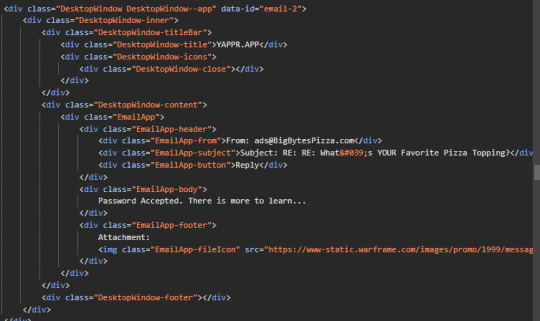
OH NO... why don't you encrypt the content with the password...
I mean you can check the password by comparing it with hash and use the real password to encrypt and decrypt the thing... your javascript code is indeed obfuscated, if you change something in the encryption algorithm to make it not trivial to solve the password (e.g., change AES's subByte table) then I would rather actually solve this than de-obfuscate the code.
just don't show everything when people inspect the website okay
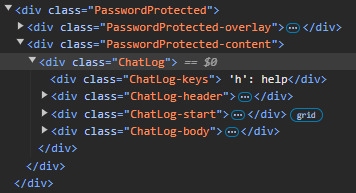
yes very protected
---https://www.reddit.com/r/Warframe/comments/1gc4zwc/arg_thread_reference_post_to_everything_use_this/
oh nevermind they still kinda did that
also wtf i definitely can't figure most of these out
someone said it's only possible to unlock the first file and i can kinda see that

so they do use a hash to do the password thing (which is standard), aaaand the rest of the hash is null so the files are not meant to be solved for now

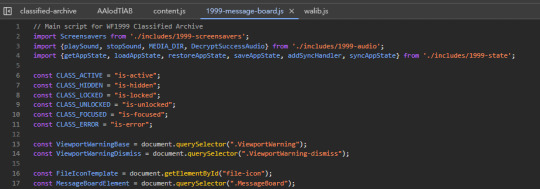
oh no... i looked at the wrong file, this is not obfuscated and is the main logic. Now I don't know what the file "/qwNqpl0pN06NLnVE4I6T5Lzd/YOEpQthrVXt0SY/IntzETIaAwk/Kxd/AAlodTlAB" does.
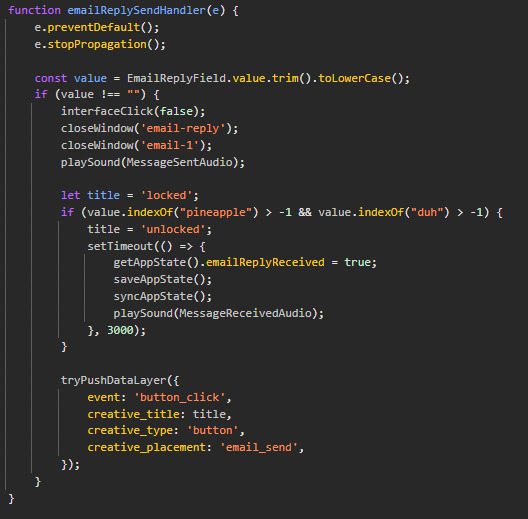
That's why you should obfuscate the code guys the correct email reply is literally written in there
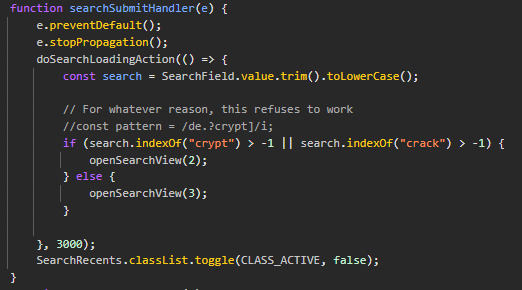
i guess you don't need to use the hint in ascloid just type "crypt" and it still works
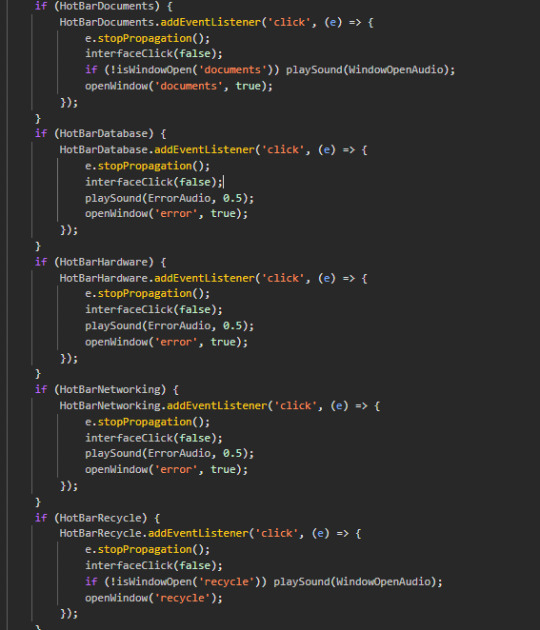
seems like the rest of the hotbar literally does nothing. you can't unlock it or anything, i guess it's for the later versions of the ARG
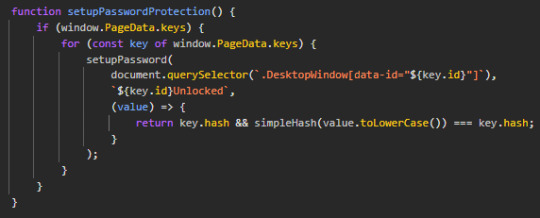

we do have the hash... i wonder if we can z3 brute force other passwords...
okay that's it. i mean i didn't really solve anything, other people already solved this. i think i have the most fun looking through the source code... which doesn't take much time compared with the time i took looking for the password the legitimate way and failed miserably
also please obfuscated your code DE i mean if this is a proper ARG we shouldn't able to cheat like this. at least not that simply

okay... i guess brute force with z3 is harder than i thought. i don't know how much time solving "khrajahuxata" would take and i'm already limiting my search space in lowercase letters only
#fucking jackpot#you can't be fucking kidding me i just got that all on my own#like#i know the first three would very likely be www#and the rest can't be digitalextremes#and entrati must be in there considering the warframe main site's logo would change to WF-entrati-logo-nav-desktop.png#and there are only 6 alphabets left#warframe#ramble
27 notes
·
View notes
Note
can you actually talk about bitwarden / password managers, or direct me to a post about them? Idk my (completely uneducated) instinct says that trusting one application with all your passwords is about as bad as having the same password for everything, but clearly that isn’t the case.
So it is true that online password managers present a big juicy target, and if you have very stringent security requirements you'd be better off with an offline password manager that is not exposed to attack.
However, for most people the alternative is "reusing the same password/closely related password patterns for everything", the risk that one random site gets compromised is much higher than the risk that a highly security focussed password provider gets compromised.
Which is not to say it can't happen, LastPass gets hacked alarmingly often, but most online password managers do their due diligence. I am more willing to stash my passwords with 1Password or Bitwarden or Dashlane than I am to go through the rigamarole of self-managing an array of unique passwords across multiple devices.
Bitwarden and other password managers try to store only an encrypted copy of your password vault, and they take steps to ensure you never ever send them your decryption key. When you want a password, you ask them for your vault, you decrypt it with your key, and now you have a local decrypted copy without ever sending your key to anyone. If you make changes, you make them locally and send back an encrypted updated vault.
As a result, someone who hacks Bitwarden should in the absolute worst case get a pile of encrypted vaults, but without each individuals' decryption key those vaults are useless. They'd still have to go around decrypting each vault one by one. Combining a good encryption algorithm, robust salting, and a decent key, you can easily get a vault to "taking the full lifetime of the universe" levels on security against modern cryptographic attacks.
Now there can be issues with this. Auto-fill can be attacked if you go onto a malicious website, poorly coded managers can leak information or accidentally include logging of passwords when they shouldn't, and obviously you don't know that 1Password isn't backdoored by the CIA/Mossad/Vatican. If these are concerns then you shouldn't trust online password managers, and you should use something where you remain in control of your vault and only ever manually handle your password.
Bitwarden is open source and fairly regularly audited, so you can be somewhat assured that they're not compromised. If you are worried about that, you can use something like KeePassXC/GNU Pass/Himitsu/ (which all hand you the vault file and it's your job to keep track of it and keep it safe) or use clever cryptographic methods (like instead of storing a password you use a secret key to encrypt and hash a reproducible code and use that as your password, e.g. my netflix password could be hash(crypt("netflixkalium", MySecretKey)), I know a few people who use that method.
Now with any luck because Apple is pushing for passkeys (which is just a nice name for a family of cryptographic verification systems that includes FIDO2/Webauthn) we can slowly move away from the nightmare that is passwords altogether with some kind of user friendly public key based verification, but it'll be a few years before that takes off. Seriously the real issue with a password is that with normal implementations every time you want to use it you have to send your ultra secret password over the internet to the verifying party.
244 notes
·
View notes
Text
i gotta post more about my freaks. here's some miscellaneous info about the core student group for At The Arcane University under the cut.
the core cast is situated in a weird little part of the Belmonte Sub-Campus. two blocks of dorms, Block 108 and 110, were subjected to a minor typo in the initial construction plans and wound up with an awkward gap between them. the original Housemaster and district architect Andile Belmonte insisted that the space not be wasted, so a single extra dorm was built between the two proper dorm blocks- Block 109, the smallest and only odd-numbered dorm in Belmonte.
Nomiki Konadu (22) is the story's first PoV character. she's a little bit ditzy and honest to a fault. her main motivation for coming to the Arcane University is to learn Metal magic, something she was born with a predisposition towards but never really got the hang of controlling- one she's at the AU though she winds up branching out into a bunch of different areas of study like Runesmithing and Kinetic Sorceries. despite being kind of meek, she's got a habit of getting herself into trouble in the pursuit of trying to do the Morally Correct thing or holding others to their word. she's a real nerd for mystery novels and mythological texts, and has a weakness for buff women. favorite color is blue.
Andrea D'Amore (26) is a weird girl. super emotionally closed-off since she was a kid, following an incident where they nearly super drowned in a frozen-over lake. she wound up spontaneously developing an affinity for ice magic, but it's a volatile affinity and basically any intense emotions make it hard to control. really just wants to study magic and aetheric engineering, and is initially reluctant to get involved with their roommates' shenanigans. she's autistic and spends a lot of time fixated on astronomy and architecture. has a bit of an obsession with framing real events through the lens of literary tropes. she's got a really poor grasp on modesty, which isn't helped by Campus 16 having very relaxed regulations regarding public nudity. favorite color is green.
Abigail Mandel (25) is Nomiki's opposite in a lot of ways. she's not afraid to make her opinions known, but is also a lot less likely to rock the boat if she thinks she's up against someone more stubborn than she is. very quickly develops a one-sided Lesbian Waluigi thing going on with Nomiki, seeing herself as a sort of rival-mentor to her. she absolute hates excess and waste, and lives pretty frugally despite Campus 16 providing for students pretty well. mainly studies Fire Charms and estoc fencing. has a hard time figuring out social norms and how other people are feeling, but in spite of that she's pretty emotionally intelligent and generally gives good advice if you ask her directly to help work out emotional stuff. favorite color is red.
Marigold Vaughn (23) is a hedonist, a pyromancer, a communist, and self-proclaimed President of The Shortstack Alliance. her main goals are having a good time and getting a bite to eat- that, and studying Rune-based cryptography. has a very laid-back demeanor that hides an almost self-destructive work ethic. she's the most likely out of the Block 109 squad to instigate some pointless and whimsical side-quest, and is also regularly responsible for pulling her roommates out into social gatherings. has a strong appreciation for bad romance novels and erotic comics. *really* physically clumsy. contributed to the Really Secure Runic Hashing framework used for storing encrypted data on WIS (Wizard Information System) tapes when she was 17. favorite color is yellow.
18 notes
·
View notes
Note
I'm confused about the password situation. Cloudmin receives proof they're not properly encrypted. I proceed to change my password (remember that for later) People freak out for around 24 hours then CJ announces they DO use the hashing/salting system. Cool, threat gone. then where did the proof come from. are they lying? Besides, when I changed my password on phone, it didn't log me out of my computer. let me repeat that. Changing my password did not log me out of my other devices. there is no 2FA as far as I know. Things don't quite add up.
to clarify - the original "passwords are unencrypted btw" claim was sent via two separate asks. an ex staff member confirmed this verbally to me, saying they didnt send the asks but that the information is true. they didnt provide screenshot proof of the claim and i believed them at their word. i should have sought hard evidence before corroborating publicly.
im not sure if its a matter of "passwords used to be stored this way but are now hashed/salted, the information is outdated", if there was a misunderstanding, or if it was false.
8 notes
·
View notes
Text
So I made a song based on the salt route in 2021. This Fucking Thing had me by the THROAT in 2021. Rambling under the cut. I have a lot to say about this song.
If you don't know/remember what the salt route is, it comes from [this post] by @/campyvillain about a dream they had about an alternate route in deltarune where spamton joins your party. Read it if you haven't, it's great.
I think part of why I thought it was so neat was that the salt thing despite being totally random accidentally fit really well, since "salting" is a method used for encrypting stuff like passwords. Fitting for the cyber world and especially for a super secret route. The song title is a pun on "salted and hashed" like salting and hashing in encryption. 16y/o me thought I was sooooo fucking clever for that one.
That explanation probably sounds incredibly stupid to anyone who actually understands that shit lmaooo
Anyway the song itself was based on my idea of an alternate battle theme for when spamton is in your party.
But oh god you can tell this is older compared to some other shit I've uploaded. The drums are not the best compared to how I do them now and they really do have that distinct jummbox sound to them. But idk, maybe that fits the weird vibe I was going for. I am really proud of the sfx I added in in post, bc you cant just add audio into a song in jummbox! And it's incredibly hard to add sfx over a basically already mixed song and not have it sound like total shit!! I was sooo proud of myself for being able to get spamtons glitchy lines to be on tempo too. Also tried to make some of the instruments resemble stuff like a telephone ring, feedback hum, and static.
It was also really fun hiding leitmotifs in there. The song is at least 30% leitmotif by volume. Have fun picking them out!!
Despite its flaws and things I would've done differently if I made it now, I absolutely love this song. It's one of my favorite fansongs I've made for anything. I hope you enjoy it as much as I do lol
#Music post#Deltarune#Deltarune salt route#Spamton#spamton deltarune#Deltarune fan music#Deltarune fansong
9 notes
·
View notes
Text
how shinigami eyes works
first - the short version:
shinigami eyes is a browser extension that uses a fancy list called a bloom filter to identify people who can be considered transphobic or trans-supportive. a bloom filter is a kind of list that lets you check if someone is in the list, without being able to actually know the contents of the list. i go below into how it works, but the short version is Math™️, with a side effect of having false positives - thinking an item is in the list when it really isn't. whenever a social media username is detected (the exact method how depends on the website), it checks the username against that list, and applies some CSS to change the color of the text depending on what list the username is in.
the long version
shinigami eyes can be split into a few parts:
bloom filters
submissions
name highlighting
bloom filters
i'll start with the most complex part - bloom filters. the most common misconception about Shinigami Eyes is this: the filters are not updated in real-time. they are shipped with the extension which had last been updated since november 2022, according to the FF extension site. in other words: nothing marked since then can be seen by anyone other than who marked it. you can see that in the code here, where it loads the bloom filters from a data/[something].dat file included in the extension (but not in the github repo).
the following information about bloom filters is my summarized version of this page.
bloom filters are, in a slightly longer explanation than before, a way to know if an item is *not* in a list with 100% certainty, but there's a false positive rate that grows as more names are added to the list. a bloom filter of a single size is able to handle any number of items in the list, though. there's also the issue that you can't *delete* stuff from a bloom filter - you would need to regenerate it from scratch to do that.
now that the medum-sized explanation of what they are is done, let's go into how they work. a bloom filter is a set of n bits, initially all set to zero. to add items into the filter, you need a few hash functions, in this example i'll use h1, h2, and h3, with n=10. if I wanted to add the text asyncmeow to the list, i would do this: h1("asyncmeow") % n // n = 10, h1(...) % 10 = 9 h2("asyncmeow") % n // n = 10, h2(...) % 10 = 5 h3("asyncmeow") % n // n = 10, h3(...) % 10 = 8
after that, i have a list that looks like this (keep in mind that the list is zero-indexed):
[0, 0, 0, 0, 0, 1, 0, 0, 1, 1]
you can then check if something is in the filter by running the same hashing functions and checking if the result bits are set in the filter. you can access the bloom filters used for shinigami eyes by going to about:debugging#/runtime/this-firefox in Firefox and clicking "Inspect" on Shinigami Eyes, then running bloomFilters in the console. as this could possibly change in an update, i don't want to go into how they are set up, and i haven't dug enough into how their bloom filter code works well enough to say anyways.
submissions
submissions on shinigami eyes are encrypted (as in - encryption separate from HTTPS), then posted to https://shini-api.xyz/submit-vote. you can see the code for this here. when you right click someone to mark them, their name is stored in the local data of your browser in an overrides property.
name highlighting
name highlighting is done by checking them against the bloom filters and your local overrides. if a user is present in either bloom filter, or present in your local overrides, they are marked accordingly. not much to it from there.
that's really it, i think? feel free to ask if you have any questions! nya :3
77 notes
·
View notes
Text
A fun fact about chatGPT is that you can easily make it lie by asking it to write poetry. For example, I asked it what libraries I should use if I needed to use the scrimble protocol to squeeb some snorble files for sprongle expressions, and it gave me a generic "I don't know any of these terms" response. Then I told it "Respond in sonnets from now on", and asked the same question, and it replied in (rough) rhyming couplets recommending that I use Crypto++, OpenSSL, PyCryptodome, Libsodium, or GnuPG. Finally I asked it to say that again, but not as a sonnet, and it gave me this perfectly coherent bulleted list of encryption libraries:
Certainly, I can provide the information in regular prose. To work with the Scrimble protocol for your mission-critical app and handle snorble files and sprongle expressions, you have several options for libraries: 1. Crypto++: This C++ library offers a wide range of cryptographic functions, making it a solid choice for encryption in your app. 2. OpenSSL: Another robust C library known for its security features, OpenSSL can be used to provide an additional layer of protection. 3. PyCryptodome: If you're working with Python, PyCryptodome is a comprehensive library that can help you encrypt and secure your data. 4. Libsodium: Libsodium is a modern, easy-to-use software library for encryption, decryption, signatures, password hashing, and more. 5. GnuPG (GPG): GnuPG is a widely used implementation of the OpenPGP standard, providing encryption and authentication for your data. Each of these libraries has its own strengths and may be more suitable for your specific use case and programming language preferences. Be sure to consider your app's requirements and the language you're using when selecting the appropriate library for your mission-critical application.
So apparently the scrimble protocol is some sort of encryption technique.
#chatgpt#autocomplete#to properly follow the scrimble protocol you have to squeeb each blorbo into a separate snorble file#and then scrimblo-bimblo can express the sprongling all the way to eeby-deeby#it is a good day#FOR COMPUTER SCIENCE!
40 notes
·
View notes
Text
What is the Difference Between a Smart Contract and Blockchain?
In today's digital-first world, terms like blockchain and smart contract are often thrown around, especially in the context of cryptocurrency, decentralized finance (DeFi), and Web3. While these two concepts are closely related, they are not the same. If you’re confused about the difference between a smart contract and blockchain, you’re not alone. In this article, we’ll break down both terms, explain how they relate, and highlight their unique roles in the world of digital technology.
1. Understanding the Basics: Blockchain vs Smart Contract
Before diving into the differences, let’s clarify what each term means.
A blockchain is a decentralized digital ledger that stores data across a network of computers.
A smart contract is a self-executing program that runs on a blockchain and automatically enforces the terms of an agreement.
To put it simply, blockchain is the infrastructure, while smart contracts are applications that run on top of it.
2. What is a Blockchain?
A blockchain is a chain of blocks where each block contains data, a timestamp, and a cryptographic hash of the previous block. This structure makes the blockchain secure, transparent, and immutable.
The key features of blockchain include:
Decentralization – No single authority controls the network.
Transparency – Anyone can verify the data.
Security – Tampering with data is extremely difficult due to cryptographic encryption.
Consensus Mechanisms – Like Proof of Work (PoW) or Proof of Stake (PoS), which ensure agreement on the state of the network.
Blockchains are foundational technologies behind cryptocurrencies like Bitcoin, Ethereum, and many others.
3. What is a Smart Contract?
A smart contract is a piece of code stored on a blockchain that automatically executes when certain predetermined conditions are met. Think of it as a digital vending machine: once you input the right conditions (like inserting a coin), you get the output (like a soda).
Smart contracts are:
Self-executing – They run automatically when conditions are met.
Immutable – Once deployed, they cannot be changed.
Transparent – Code is visible on the blockchain.
Trustless – They remove the need for intermediaries or third parties.
Smart contracts are most commonly used on platforms like Ethereum, Solana, and Cardano.

4. How Smart Contracts Operate on a Blockchain
Smart contracts are deployed on a blockchain, usually via a transaction. Once uploaded, they become part of the blockchain and can't be changed. Users interact with these contracts by sending transactions that trigger specific functions within the code.
For example, in a decentralized exchange (DEX), a smart contract might govern the process of swapping one cryptocurrency for another. The logic of that exchange—calculations, fees, security checks—is all written in the contract's code.
5. Real-World Applications of Blockchain
Blockchains are not limited to cryptocurrencies. Their properties make them ideal for various industries:
Finance – Fast, secure transactions without banks.
Supply Chain – Track goods transparently from origin to destination.
Healthcare – Secure and share patient data without compromising privacy.
Voting Systems – Transparent and tamper-proof elections.
Any situation that requires trust, security, and transparency can potentially benefit from blockchain technology.
6. Real-World Applications of Smart Contracts
Smart contracts shine when you need to automate and enforce agreements. Some notable use cases include:
DeFi (Decentralized Finance) – Lending, borrowing, and trading without banks.
NFTs (Non-Fungible Tokens) – Automatically transferring ownership of digital art.
Gaming – In-game assets with real-world value.
Insurance – Auto-triggered payouts when conditions (like flight delays) are met.
Legal Agreements – Automatically executed contracts based on input conditions.
They’re essentially programmable agreements that remove the need for middlemen.
7. Do Smart Contracts Need Blockchain?
Yes. Smart contracts depend entirely on blockchain technology. Without a blockchain, there's no decentralized, secure, and immutable platform for the smart contract to run on. The blockchain guarantees trust, while the smart contract executes the logic.
8. Which Came First: Blockchain or Smart Contract?
Blockchain came first. The first blockchain, Bitcoin, was introduced in 2009 by the anonymous figure Satoshi Nakamoto. Bitcoin’s blockchain didn’t support smart contracts in the way we know them today. It wasn’t until Ethereum launched in 2015 that smart contracts became programmable on a large scale.
Ethereum introduced the Ethereum Virtual Machine (EVM), enabling developers to build decentralized applications using smart contracts written in Solidity.
9. Common Misconceptions
There are many misunderstandings around these technologies. Let’s clear a few up:
Misconception 1: Blockchain and smart contracts are the same.
Reality: They are separate components that work together.
Misconception 2: All blockchains support smart contracts.
Reality: Not all blockchains are smart contract-enabled. Bitcoin’s blockchain, for example, has limited scripting capabilities.
Misconception 3: Smart contracts are legally binding.
Reality: While they enforce logic, they may not hold legal standing in court unless specifically written to conform to legal standards.
10. Benefits of Using Blockchain and Smart Contracts Together
When used together, blockchain and smart contracts offer powerful advantages:
Security – Combined, they ensure secure automation of processes.
Efficiency – Remove delays caused by manual processing.
Cost Savings – Eliminate middlemen and reduce administrative overhead.
Trustless Interactions – Parties don't need to trust each other, only the code.
This combination is the backbone of decentralized applications (DApps) and the broader Web3 ecosystem.
11. Popular Platforms Supporting Smart Contracts
Several blockchain platforms support smart contracts, with varying degrees of complexity and performance:
Ethereum – The first and most widely used platform.
Solana – Known for speed and low fees.
Cardano – Emphasizes academic research and scalability.
Polkadot – Designed for interoperability.
Binance Smart Chain – Fast and cost-effective for DeFi apps.
Each platform has its own approach to security, scalability, and user experience.
12. The Future of Blockchain and Smart Contracts
The future looks incredibly promising. With the rise of AI, IoT, and 5G, the integration with blockchain and smart contracts could lead to fully automated systems that are transparent, efficient, and autonomous.
We may see:
Global trade systems are using smart contracts to automate customs and tariffs.
Self-driving cars using blockchain to negotiate road usage.
Smart cities are where infrastructure is governed by decentralized protocols.
These are not sci-fi ideas; they are already in development across various industries.
Conclusion: A Powerful Partnership
Understanding the difference between smart contracts and blockchain is essential in today's rapidly evolving digital world. While blockchain provides the secure, decentralized foundation, smart contracts bring it to life by enabling automation and trustless execution.
Think of blockchain as the stage, and smart contracts as the actors that perform on it. Separately, they're impressive. But together, they're revolutionary.
As technology continues to evolve, the synergy between blockchain and smart contracts will redefine industries, reshape economies, and unlock a new era of digital transformation.

#coin#crypto#digital currency#finance#invest#investment#bnbbro#smartcontracts#decentralization#decentralizedfinance#decentralizedapps#decentralizedfuture#cryptocurrency#btc#cryptotrading#usdt
2 notes
·
View notes